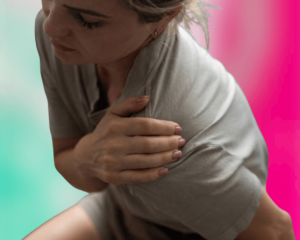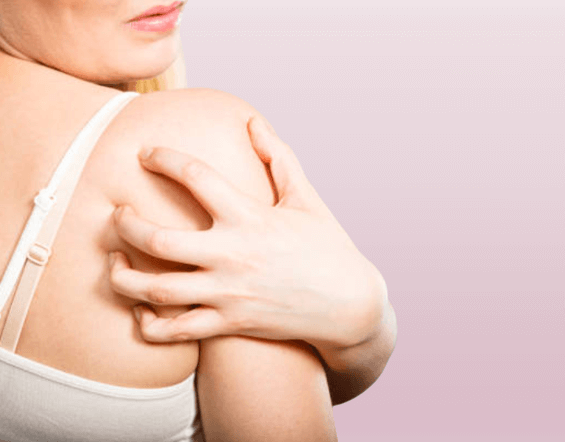Did you know that postpartum shoulder pain is a common discomfort experienced by many women after giving birth? It’s something that may catch new mothers off guard, but rest assured, it’s a temporary condition that can be effectively managed. In this article, we will explore the causes of postpartum shoulder pain and discuss some practical tips to help alleviate this discomfort so that you can focus on enjoying your new bundle of joy. So, let’s get started on tackling this pesky pain together!
Causes of Postpartum Shoulder Pain

Hormonal Changes
After giving birth, your body goes through significant hormonal changes as it adjusts to the postpartum period. These hormonal fluctuations can contribute to shoulder pain. The sudden drop in estrogen and progesterone levels may lead to joint and muscle inflammation, causing discomfort in your shoulders.
Muscle Strain and Tension
During pregnancy, your body undergoes physical changes to accommodate the growing baby. This can result in muscle strain and tension in various areas, including your shoulders. The additional weight, changes in posture, and increased stress on the muscles can lead to shoulder pain postpartum.
Nerve Compression
Sometimes, the position of the baby during pregnancy can cause nerve compression in the shoulder area. This compressed nerve can lead to pain and discomfort in the postpartum period. The hormonal changes mentioned earlier can also contribute to nerve sensitivity and increase the likelihood of nerve compression.
Lack of Exercise during Pregnancy
A lack of regular exercise during pregnancy can contribute to shoulder pain. Exercise helps to strengthen the muscles and improve flexibility, which can reduce the risk of muscle strain and tension. When you don’t engage in regular exercise during pregnancy, your muscles may be more susceptible to discomfort and pain after giving birth.
Symptoms of Postpartum Shoulder Pain
Shoulder Stiffness
One of the common symptoms of postpartum pain is stiffness in the shoulder joint. You may find it difficult to move your shoulder freely or experience resistance when trying to perform certain movements.
Limited Range of Motion
Another symptom is a limited range of motion in the shoulder. You may not be able to reach or lift objects as easily as before, and simple actions like reaching behind your back may cause discomfort.
Pain while Lifting Objects
Postpartum shoulder pain can also be triggered or worsened when lifting objects. The strain on the muscles and joints during lifting can lead to increased pain and discomfort.
Pain during Breastfeeding
Breastfeeding can also contribute to postpartum pain. The position and posture adopted while nursing can strain the shoulder muscles and joints, resulting in pain.
>> Read more: Stomach pain after tooth extraction
Diagnosing Postpartum Shoulder Pain
Physical Examination
To diagnose postpartum pain, a physical examination is often conducted. During the examination, the healthcare provider will assess the range of motion, strength, and flexibility of your shoulders. They may also palpate the area to identify any specific points of tenderness.
Medical History
Your medical history, including any previous injuries or conditions related to the shoulder, will be taken into consideration. This information helps the healthcare provider understand the potential causes and determine the appropriate course of treatment.
Imaging Tests
In some cases, imaging tests may be necessary to diagnose postpartum shoulder pain. X-rays, ultrasound, or MRI scans can provide detailed images of the shoulder, allowing healthcare professionals to identify any underlying structural issues or abnormalities.
Specialized Tests
If the cause of your postpartum shoulder pain is unclear, specialized tests such as electromyography (EMG) or nerve conduction studies may be recommended. These tests can help evaluate the function of muscles and nerves in the shoulder area, providing further insight into the underlying cause of the pain.
Preventing Postpartum Shoulder Pain
Maintaining Good Posture during Pregnancy
Keeping good posture during pregnancy can help reduce the risk of postpartum pain. Be mindful of your posture, especially as your baby bump grows. Engaging your core muscles and keeping your shoulders relaxed and aligned can alleviate stress on the shoulders.
Practicing Safe Lifting Techniques
To prevent strain on your shoulders, it’s important to practice safe lifting techniques, both during pregnancy and after giving birth. Bend your knees, keep your back straight, and use your leg muscles to lift objects instead of putting strain on your shoulders.
Engaging in Regular Exercise
Regular exercise during pregnancy is key to maintaining muscle strength and flexibility. Exercises that target the shoulders, such as gentle stretches and strength training, can help prevent postpartum pain. Consult with your healthcare provider before starting an exercise routine during pregnancy.
Using Supportive Pillows during Sleep
Investing in supportive pillows during pregnancy can help maintain proper spinal alignment while sleeping. This can alleviate strain on the shoulders and reduce the likelihood of shoulder pain. Experiment with different types of pillows to find the most comfortable and supportive option for you.
Treatment Options for Postpartum Shoulder Pain
Physical Therapy and Rehabilitation Exercises
Physical therapy and rehabilitation exercises are commonly recommended for shoulder pain. A physical therapist can design a customized exercise program to target the specific muscles and joints in the shoulder, helping to alleviate pain and improve range of motion.
Pain Medication
Over-the-counter pain medications, such as acetaminophen or ibuprofen, may be recommended to help manage postpartum pain. It is important to consult with your healthcare provider or pharmacist before taking any medications, especially if you are breastfeeding.
Heat or Cold Therapy
Applying heat or cold therapy to the affected shoulder can provide temporary relief from pain and inflammation. You can use a heating pad or take a warm shower, or apply a cold pack or ice wrapped in a thin towel to the area. Alternate between heat and cold therapy for best results.
Massage Therapy
Massage therapy can help relax the muscles in the shoulder, reduce tension, and increase blood circulation. Consider scheduling a session with a certified massage therapist who specializes in postpartum care. Make sure to inform the therapist about your specific symptoms and concerns.
>> Read more: Pregnant stomach rumbling
Home Remedies and Self-Care Tips
Applying Warm Compresses
Applying warm compresses to the affected shoulder can help relax the muscles and relieve pain. You can use a warm towel or a heating pad set to a comfortable temperature. Apply the compress for about 15-20 minutes, several times a day, or as needed.
Using Over-the-Counter Pain Relief Creams
Over-the-counter pain relief creams or gels containing ingredients like menthol, camphor, or capsaicin can provide temporary relief from postpartum shoulder trauma. Follow the instructions on the packaging and apply as directed, gently massaging the cream into the affected area.
Engaging in Gentle Stretching and Strengthening Exercises
In addition to the exercises recommended by a physical therapist, there are gentle stretching and strengthening exercises you can perform at home to alleviate postpartum shoulder discomfort. These exercises should be done under the guidance of a healthcare professional to ensure proper form and technique.
Getting Sufficient Rest and Sleep
Adequate rest and sleep are crucial for your body’s healing process after giving birth. Make sure to prioritize rest and create a sleep-friendly environment. Use supportive pillows and find a comfortable sleeping position to reduce strain on the shoulders while you sleep.
When to Seek Medical Assistance
Persistent or Worsening Pain
If your postpartum shoulder injure persists or worsens despite home remedies and self-care measures, it is important to seek medical assistance. Persistent or worsening pain could indicate a more serious underlying issue that requires medical intervention.
Difficulty with Daily Activities
If your shoulder pain is interfering with your ability to perform daily activities, such as caring for your baby or completing household tasks, it is recommended to consult a healthcare professional. They can assess the severity of your symptoms and provide appropriate treatment options.
Decreased Sensation in the Shoulder
If you experience any numbness or tingling in the shoulder area along with the pain, it could indicate nerve involvement. This requires medical attention to evaluate and determine the best course of treatment.
Signs of Infection
If you notice any signs of infection, such as redness, swelling, or warmth around the shoulder, it is important to seek immediate medical assistance. Infections can lead to serious complications if left untreated.
Complications and Long-term Effects
Chronic Pain
If postpartum shoulder pain is not properly addressed, it can develop into chronic pain, which can significantly impact your quality of life. Chronic pain may require more extensive treatment options and ongoing management.
Limited Mobility
Persistent shoulder pain can lead to limited mobility, making it difficult to perform regular activities and engage in physical exercise. This limited mobility can further exacerbate muscle weakness and stiffness.
Impact on Daily Functioning
Postpartum shoulder trauma can affect your ability to care for your baby, perform household chores, and engage in other daily activities. It is important to address the pain promptly to minimize its impact on your daily functioning.
Emotional and Mental Health Challenges
Dealing with chronic pain can take a toll on your emotional and mental well-being. It is common to experience feelings of frustration, stress, and even depression when dealing with postpartum shoulder pain. Seeking professional support and joining support groups can help you navigate the emotional challenges.
Postpartum Shoulder and Neck Pain
Postpartum shoulder and neck pain is a common issue that many new mothers experience. This pain can be caused by a variety of factors, including breastfeeding, carrying the baby, and poor posture. It is essential to address this pain as soon as possible to prevent it from worsening and affecting daily activities.

One of the main causes of postpartum shoulder and neck pain is breastfeeding. This activity requires mothers to hold their babies for extended periods, which can cause strain on the shoulders and neck. To prevent this pain, mothers should ensure that they are using proper breastfeeding techniques, such as supporting the baby’s head and using a comfortable chair with good back support.
Carrying the baby can also cause postpartum shoulder and neck pain. New mothers may use one arm to carry the baby, causing strain on that side of the body. To prevent this pain, mothers should switch arms frequently and use a baby carrier or sling to distribute the weight evenly.
Poor posture is another cause of postpartum shoulder and neck pain. New mothers may slouch when holding their baby or breastfeeding, causing strain on the shoulders and neck. To prevent this pain, mothers should practice good posture by sitting up straight and using a pillow to support the baby’s head during breastfeeding.
>> Read more: Gurgling in Stomach pregnancy
Shoulder Pain After C-Section Delivery
Shoulder pain after a C-section delivery is a common complaint among new mothers. The pain can be severe and can last for a few hours or days. It is often described as a sharp, stabbing pain in the shoulder blade area.
The exact cause of postpartum shoulder pain is not clear, but it is believed to be caused by the accumulation of gas in the abdominal cavity during the surgical procedure. The gas can irritate the diaphragm, which can then cause referred pain in the shoulder.
To alleviate the pain, new mothers are advised to take pain medications as prescribed by their doctor. They can also try the following tips:
- Applying heat or cold compress to the affected area
- Gentle stretching exercises
- Deep breathing exercises to help release trapped gas
- Walking around to help stimulate bowel movements and release trapped gas
How to Relieve Gas Pain in Shoulder After C-Section
Gas pain in the shoulder after a C-section is a common postoperative symptom. The discomfort is caused by the accumulation of gas in the abdomen, which can travel and irritate the diaphragm and surrounding nerves. There are several ways to alleviate this pain.
- Gentle Stomach Massage
A gentle stomach massage can help to break up pockets of gas in the abdomen and relieve the pain in the shoulder. However, great care should be taken after a C-section due to the nearby incision, which should not be injured or irritated. It is recommended to consult with a healthcare provider before attempting any massage techniques.
- Walking
Walking can help to stimulate the digestive system and promote the release of gas. It can also help to relieve tension in the shoulder and improve circulation. However, it is important to start slowly and gradually increase the duration and intensity of the walks, as well as to avoid any strenuous activities that could strain the incision site.
- Activated Charcoal
Activated charcoal is often taken by those wanting to reduce levels of gas in their system. It works by absorbing gas and toxins in the digestive tract and preventing them from being absorbed into the bloodstream. However, it is important to consult with a healthcare provider before taking any supplements, especially if breastfeeding.
- Warm Compress
A warm compress can help to relax the muscles and relieve the pain in the shoulder. It can also help to improve blood flow and promote healing. A warm towel or heating pad can be applied to the affected area for 15-20 minutes, several times a day.
- Medications
Over-the-counter medications such as simethicone or antacids can also help to relieve gas pain in the shoulder. However, it is important to consult with a healthcare provider before taking any medications, especially if breastfeeding.
What Causes Shoulder Pain After C-section
One of the main causes of shoulder pain after a C-section is the effect of CO2 pneumoperitoneum. During the surgery, carbon dioxide gas is used to inflate the abdomen to create space for the surgeon to operate. This can cause the diaphragm to be pushed upwards, which can irritate the nerves that run from the diaphragm to the shoulder. The irritation of these nerves can cause pain in the shoulder.
Another cause is peritoneal stretching. The peritoneum is the lining of the abdominal cavity, and during a C-section, it is stretched to make room for the baby. This stretching can irritate the nerves that run from the peritoneum to the shoulder, resulting in pain in the shoulder.
Diaphragmatic irritation is also a possible cause of shoulder pain after a C-section. The diaphragm is a muscle that separates the chest cavity from the abdominal cavity. During a C-section, the diaphragm can be irritated, which can cause pain in the shoulder.
How to Treat Shoulder Pain After C-section
Pain Medication
To soothe incision soreness, healthcare providers may recommend pain relief medication, such as ibuprofen (Advil, Motrin IB, others), acetaminophen (Tylenol, others), or other medications to relieve pain. Most pain relief medications are safe for breastfeeding women. However, it is important to consult with a healthcare provider before taking any medication.
Heat Therapy
Applying heat to the affected area can help alleviate shoulder pain. A hot compress held across the belly and shoulder can help to soothe any aches and pains. Heating pads or warm towels can also be used. However, make sure the heat source is not too hot to avoid burning the skin.
Massage
Gentle stomach massage can help to break up pockets of gas. However, great care should be taken after a C-section due to the nearby incision, which you do not want to injure or irritate. Massage should be done by a trained professional or under the guidance of a healthcare provider.
Activated Charcoal
Activated charcoal can be used to absorb gas in the digestive system, which can help alleviate shoulder pain. It is available in supplement form and can be taken after consulting with a healthcare provider.
How Long Does Shoulder Pain Last After C-Section?
According to a study published by the National Center for Biotechnology Information, the incidence of shoulder tip pain (STP) after C-section was 35.7%. The pain was reported to last for a mean duration of 4.5 days in the study population. However, the duration of the pain can vary depending on several factors such as the individual’s pain tolerance, surgical technique, and the amount of gas used during surgery.
While shoulder pain is a common side effect after C-section, it should not be ignored. If the pain persists or worsens, it could be a sign of a more serious complication such as an infection or blood clot. It is recommended to speak with a healthcare provider if the pain is severe or accompanied by other symptoms such as fever, redness, or swelling.
Professional Support for Postpartum Shoulder Pain
Consulting a Physical Therapist or Chiropractor
If you are experiencing postpartum shoulder pain, consulting a physical therapist or chiropractor who specializes in postpartum care can be beneficial. They can assess your condition, create a personalized treatment plan, and guide you through exercises and stretches to alleviate pain and improve mobility.
Seeking Guidance from a Prenatal and Postnatal Fitness Specialist
A prenatal and postnatal fitness specialist can provide guidance on safe and effective exercises to strengthen the shoulder muscles and promote overall fitness during the postpartum period. They can also offer advice on proper posture and lifting techniques to minimize the risk of shoulder pain.
Joining Support Groups or Counseling
Dealing with postpartum shoulder pain can be emotionally challenging. Joining support groups or seeking counseling can provide a safe space to share your experiences, receive support from others, and gain coping strategies to manage the emotional and mental health challenges associated with chronic pain.
Conclusion
Postpartum shoulder pain can significantly impact your daily life as a new mother. Understanding the various causes, symptoms, and treatment options is essential to effectively manage and prevent this discomfort. By incorporating preventive measures, seeking professional support when needed, and practicing self-care, you can minimize the impact of postpartum shoulder pain and enjoy the precious moments with your baby. Remember to consult with your healthcare provider for a proper diagnosis and personalized treatment plan that suits your individual needs.
